Year / Model: 1965 Vox Bassmaster
Serial number: 70205
Body: 17 5/8" x 12 1/4" x 1 1/4". Solid mahogany body
Neck: One-piece sycamore with non adjustable truss-rod. Rosewood fingerboard with mother-of-pearl dot inlays
Scale: 30"
Width at nut: 1 5/16"
Width at 12th fret: 1 11/16"
Weight: 3.20kg
The Vox Bassmaster was an early-mid 1960s British-built bass, competitively priced, and as Vox basses go, made in relatively large numbers. It was a solid body, short scale (30") instrument, with a very thin neck, thinner than the other basses available - aimed at student musicians, or guitarists wanting to play a little bass. It is not a bad sounding bass (have a listen to the soundclips) although a bit tricky to play for people with larger hands.
The neck is bolt-on of course, as was generally the case with Vox, and was made by a British furniture makers, G-plan in Hemel Hempstead. Note that there is no truss rod adjustment nut: although a rod is fitted, it is not adjustable.
This one, built in late 1965 (though probably not shipped and sold until early 1966), has a solid mahogany body, sycamore neck and rosewood fretboard with dot inlays. This is an unusual finish; red was by far the most widely used. Some are available in different body woods, both one-piece and laminate (the oldest ones) - see a 1963 Bassmaster, with laminate body here.
The UK price for this bass in late 1965 was £28 7s - slightly more expensive than the Clubman bass at £23 10s, but less than a third of the price of the much better quality Symphonic and Mark IV (teardrop) basses which were priced £94 10s.
A closer look at a 1965 Vox Bassmaster
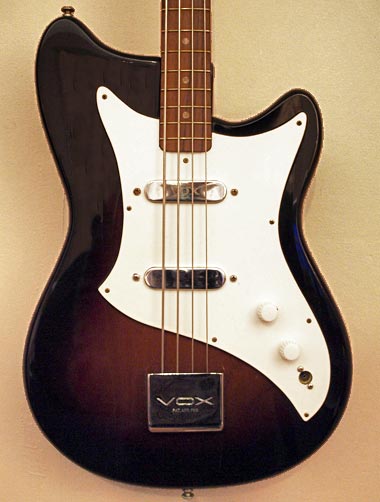
This two-tone brown-black burst of this bass is an unusual feature; the vast majority were red, although white is also listed in Vox literature. See also a
1963 Bassmaster with three-tone burst finish.
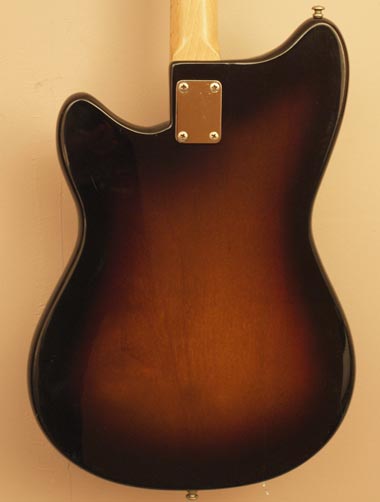
The Bassmaster, like all other Vox bass guitars of the 1960s, had a simple construction. The neck was attached to the body via 4 bolts, as seen here.
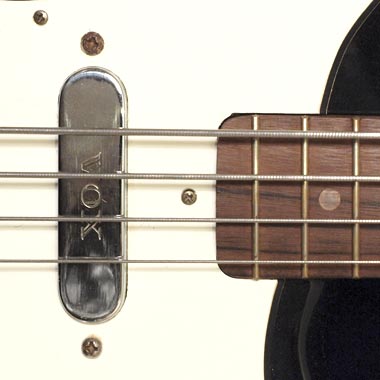
The Sycamore neck with rosewood fingerboard joins the body at the 15th fret. The Bassmaster had two
Vox chrome single coil pickups. These pickup casings often had this Vox logo, though not always. Guitars with none, one or two pickup logos are all common. The pickups themselves are basic single-coils - follow the link above for more details.
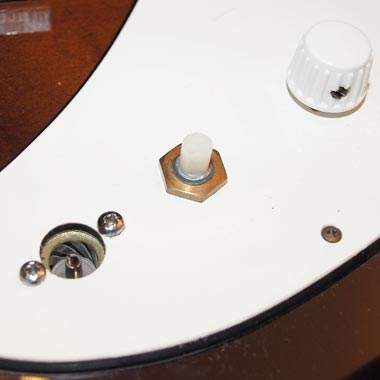
Bassmaster guitars were generally fitted with the JMI
white plastic control knobs, as seen here. The 1966 US
Bassmaster parts list also suggests a metal knob (perhaps primarily for mid sixties US imports) but UK models almost invariably used the white plastic version shown. This example is still fitted with the original coaxial input. It seems odd that Vox were still selling these as late as 1966, but they were. Have a look at the
Vox Bassmaster circuit information, which has a close up of the input itself. Controls are typical JMI
white plastic type.
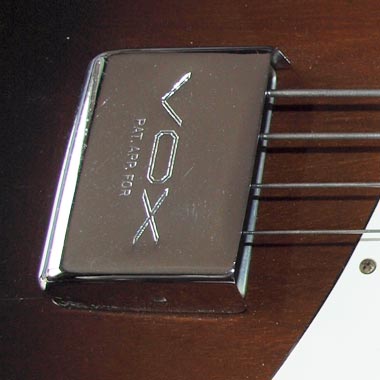
This chrome-plated bridge and cover assembly was fitted to all Bassmaster and
Clubman basses produced at the Dartford (UK) Vox plants, circa 1962-67. The bridge cover (part 09-304-0) with large Vox logo, simply clips to the bridge base plate sides; two indentations on the cover fit into holes on the bridge. Note the 'Patent applied for' notification, presumably referring to this fact?
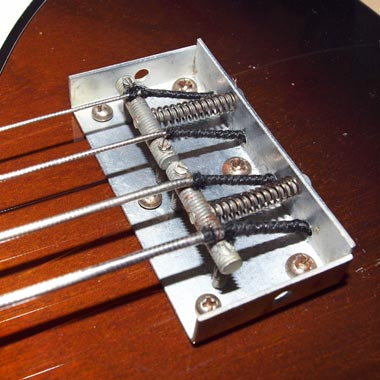
The Vox compensating bridge (part number 09-303-0) did not change over the period of Vox production. It was a simple, but very effective design, similar to that of a
Fender Precision: basically a pressed metal plate attached to the body with six screws. It had just two saddles, each holding two strings. Two grub screws through each saddle gave height adjustment, whilst one screw into the rear of the baseplate allowed adjustment of intonation.
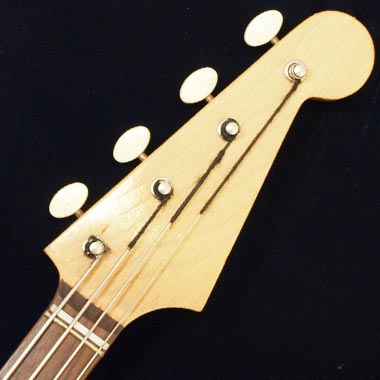
Rosewood fingerboard, plain lacquered sycamore neck/headstock. One usually expects to see some decals on a Vox headstock: typically denoting the model and/or JMI as the manufacturer. Catalogue images regularly have plain headstocks, and it would seem that this bass was shipped with neither. It is possible of course that they were removed, but the is no evidence of this, and the otherwise original condition of the bass also suggests otherwise. Have a look at the headstock of a 1963 Bassmaster with original decal
here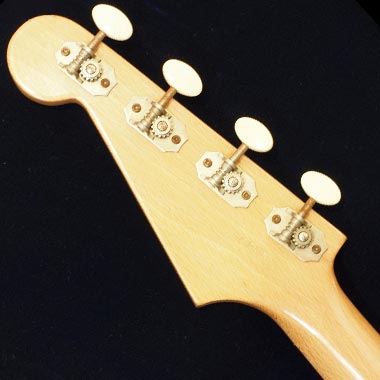
The individual open-gear tuners, with plastic buttons, (
part 09-301-0) fitted to Vox Bassmaster guitars were also installed on the
Clubman bass, but also early versions of several six string models, such as the
Vox Ace. The neck is one-piece sycamore, with a width at the nut of just 1 5/16". Very thin indeed.
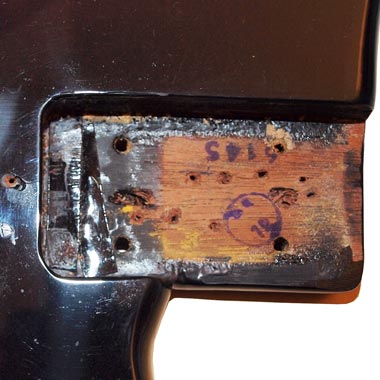
Vox Bassmaster guitars were made from a variety of different woods; initially (early 1960s, roughly 1962-63) they were all laminate, (i.e. consisting of numerous layers of thin woods - see an example
here). Later in the decade Vox tried bodies of other solid woods, certainly mahogany, as can be seen here with it's rich brown colouration, but also lighter coloured woods, probably agba, but maybe also sycamore. The later, solid wood Bassmasters are by far the nicer instruments. In order to transmit vibrations between neck and body, neck pockets are typically left unfinished, which is helpful when it comes to examining the materials used. The rich orange/brown colour of the unfinished mahogany is clearly evident. Note also the code 6145 in ink.
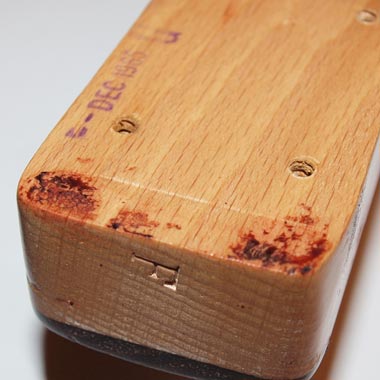
The far end of the neck also contains some markings. The date (December 1965) and G (for G-plan) give obvious information about where and when this neck was produced. Note also the large F stamped into the butt of the neck. The meaning of this is currently unknown. If you know the meaning of this (or have a theory!) please
comment.
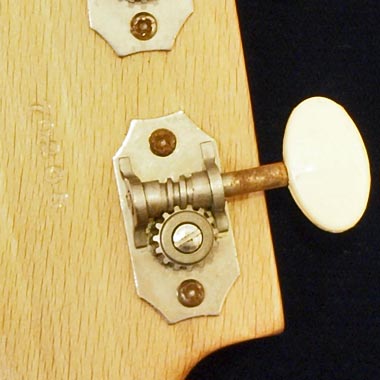
The open gear machine heads used on the Vox Bassmaster were also fitted to the Vox Clubman bass, but also some guitars, such as early versions of the Vox Ace, Super Ace, Duotone etc - see a
1963 Ace for example. UK-built Vox guitars and basses usually had a five digit serial number stamped into the back of the headstock, usually by the E-tuner, as seen here. Some late UK produced Vox guitars had the number stamped into the metal neckplate, but these are very much the exception.
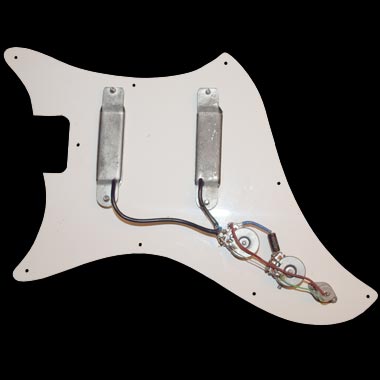
Electronically, the Vox Bassmaster is very simple: two single-coil
Vox V1 pickups, with just one volume and one tone control (both 250kΩ - see a
circuit diagram here) - all scratchplate mounted for ease of production and assembly. The Vox Bassmaster does not allow the selection of individual pickups, which is somewhat unusual in a two-pickup guitar.
Got an opinion on the contents of this page? Disagree with something written above? Please
comment













